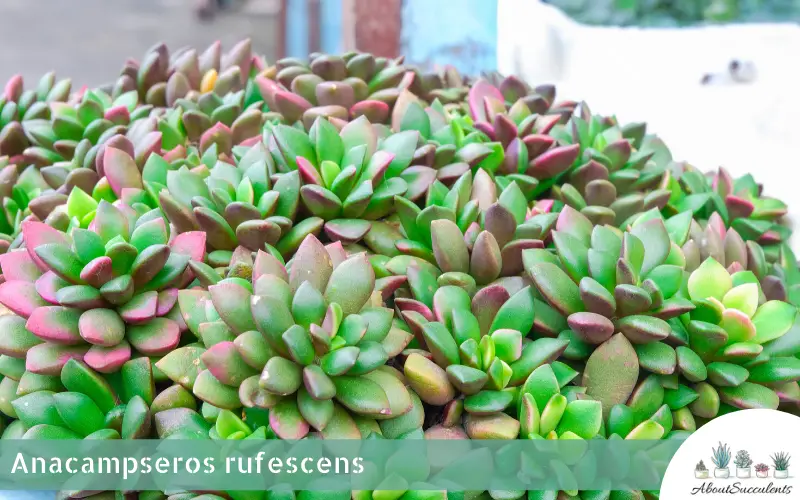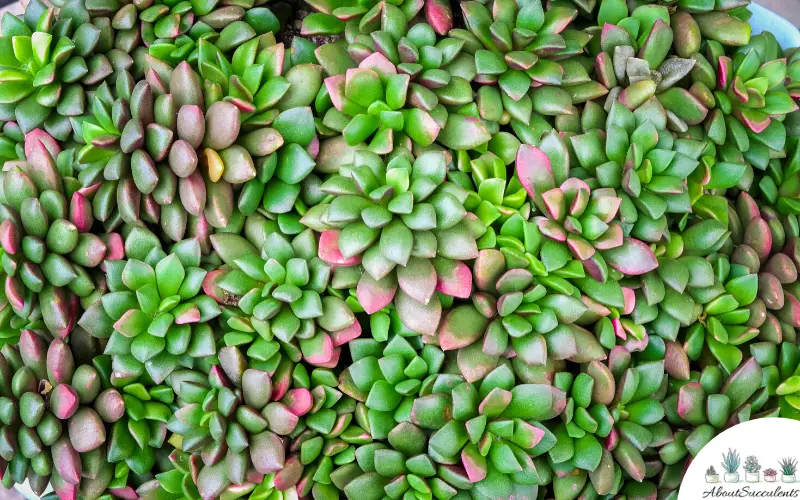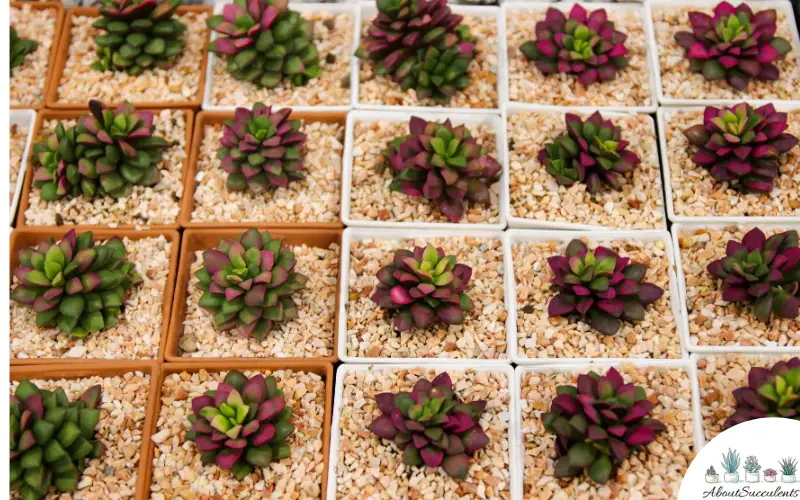
Anacampseros rufescens is a gorgeous succulent plant that grows in small clusters but over time, spreads out by producing “pups” or offsets. Horticulturists love to grow Anacampseros rufescens as ground cover.
The leaves of this rather unusual-looking plant are rainbow-colored; its foliage exhibiting shades of yellow-green, green, pink, and purple. When the succulent is stressed, the dark green colors of the leaves turn to red. You can see thin, white hair growing around Anacampseros rufescens.
Anacampseros rufescens develops rosettes that are 4-inches (10cm) tall and 4-inches wide. The single flowers that are colored pink or rose-purple grow on stems that measure 3-inches (7cm) above the leaves. The succulent can grow up to 24-inches (61cm) tall and 24-inches wide.
Anacampseros rufescens is also called “Sand Rose” or Sunrise Succulent”. It originates from the Portulacaceae family and is native to South Africa.
General Information:
Also known as: Sand Rose, Sunshine Succulent
Plant Family: Portulacaceae
Origin: South Africa
Height: 24-inches (61cm)
Exposure: Partial to full sunlight; 4 to 6 hours per day.
Water Needs: Water only when soil is dry to the touch, little watering during the winter months.
Soil Type: Cactus soil mixed with perlite at a 1:1 ratio
Soil pH: Slightly acidic (6.1 to 6.5 pH)
Tolerance: Drought
How to Grow and Care for Anacampseros Rufescens

Anacampseros rufescens is easy to grow and care for. It is very resilient to diseases. You only have to worry about root rot which can be caused by overwatering.
Although Sand Rose appears to grow best when planted in a garden, you can also have success growing this beautiful plant indoors.
1. Sunlight
Anacampseros rufescens grows better and achieves its deep green colors when given partial to full sun exposure.
Without enough sunlight, the leaves will lose their colors. The leaves may also stretch out and grow limp. This is a process known as etiolation where the leaves appear to be searching for more sunlight.
As a ground cover in an outdoor garden, place Anacampseros rufescens in a location that gets 4 to 6 hours of morning sunlight every day.
If grown indoors, place Sand Rose near a window that gets a good amount of sunlight per day.
2. Watering
Give Sand Rose water only when the soil is dry to the touch. You can also use moisture meters or a hygrometer to measure the moisture content of the soil.
In the summer months, Anacampseros rufescens may be watered every 7 to 10 days. During winter, where the soil tends to hold moisture longer, you may have to cut back on the watering schedule further.
It is better to under-water a succulent than to overwater because if the roots remain moist for a long time, it could lead to root rot.
3. Pot and Soil
The best pot for Anacampseros rufescens is clay which allows for proper evaporation of water from the soil.
Always plant Sand Rose in well-draining soil such as cactus soil. Add perlite at a 1:1 ratio to cactus potting mix for better drainage.
How to Propagate Anacampseros Rufescens

Propagating Anacampseros might be a bit of a challenge but you can get it done with the use of its offsets.
Step 1: Sand Rose grows offsets over time. Look for offsets that are large enough to be propagated and pull them out with their roots intact.
Step 2: Keep the offsets in a dry and shaded area to allow them to harden and develop calluses.
Step 3: Once the offsets have dried out completely, plant them in well-draining soil.
Step 4: Water the soil when it is completely dry.
Frequently Asked Questions
Is Anacampseros Rufescens Toxic for Cats and Dogs?
Anacampseros rufescens does not appear in the list of plants that are toxic to cats and dogs that appear on the website of the American Society for the Prevention of Cruelty to Animals (ASPCA).
The list does not cover all succulent plants. If your pet shows symptoms of poisoning such as vomiting and gastrointestinal distress after coming in contact with Sand Rose, visit your Veterinarian right away.
Why is my Anacampseros Rufescens Succulent Dying?
Overwatering is the leading cause of death for succulents. If the roots are kept submerged in water for a long period, it will rot. Once the roots start to rot, it will get infected which can spread to other parts of Sand Rose.
You will get an idea that Sand Rose has a case of root rot if the leaves start to get discolored. The leaves might show a brownish color. When you notice discoloration, cut off the infected parts of the plant with a sterilized and sharpened pair of garden shears.
Once the infected parts have been cut off, gently remove Sand Rose from the soil. Shake off excess soil so you can see how far the rotting has spread to the roots. Cut off the infected roots with the shears.
Allow Anacampseros rufescens to dry out completely. In the meantime, fill out a new clay pot with fresh, well-draining soil. Re-plant Sand Rose when it has dried out.
Does Anacampseros Rufescens Produce Flowers?
Yes, Anacampseros rufescens produces flowers in the spring or summertime. The flowers may appear with a pinkish or purple-red color and emit a mild fragrance.
Last Updated on June 10, 2022 by Sofia Lara